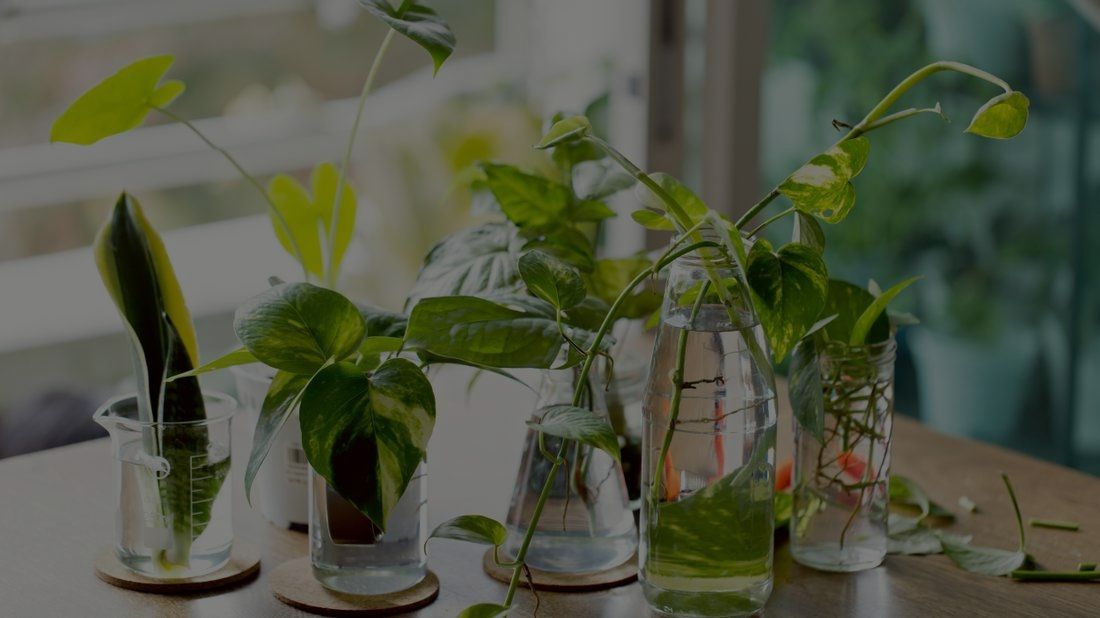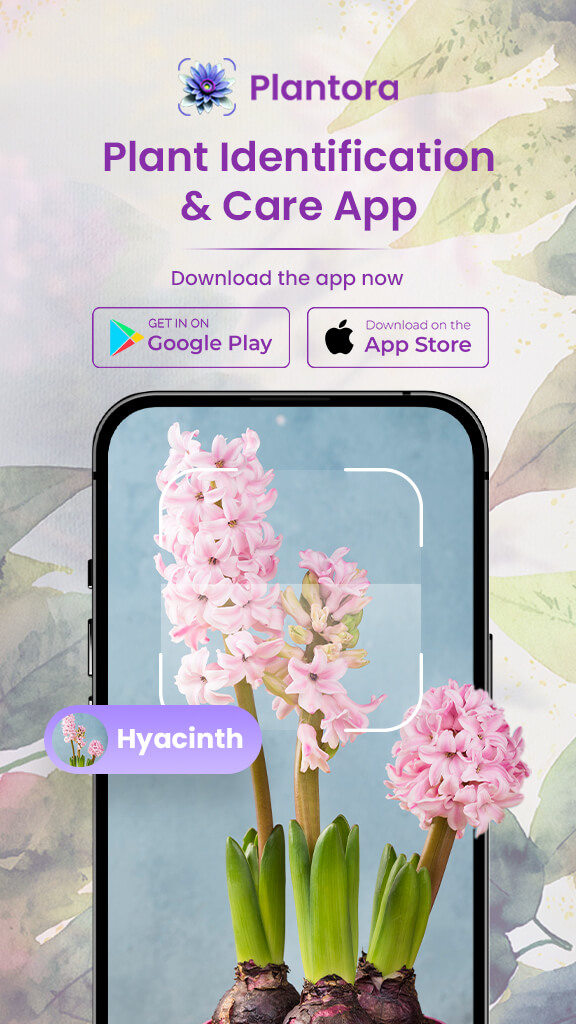
Water-growing plants are a mess-free, low-maintenance option to enjoy greens indoors. Many common houseplants and herbs grow well in hydroponic systems, regardless of whether you’re a busy plant parent or simply choose not to use soil.
These plants can be easily grown in a vase or a glass jar. Moreover, plants that can grow in water are the ideal choice for kitchens or bathrooms as they are dirt—and pest-free.
In this blog, we’ve covered 15 plants that grow in water, including maintenance advice and the unique characteristics of each.
Top 15 Water-Growing Plants
1. Pothos

Pothos are the most well-liked and low-maintenance indoor plants. They are distinguished by their heart-shaped leaves and trailing vines with variegated patterns and green, yellow, and green hues. These water-growing plants are ideal for novices because they are very simple to propagate and grow in water.
Cutting a healthy vine just below a node, removing the lower leaves, and putting the stem in a jar of clean, room-temperature water is the first step. Moreover, pothos grows in water for a long time and roots swiftly.
2. Lucky Bamboo

Despite its name, lucky bamboo belongs to the Dracaena family and is not a real bamboo. They are commonly planted in vases filled with water and supported with ornamental pebbles. In addition to being incredibly easy to maintain in water, these plants that grow in water are also considered lucky Feng Shui plants.
Always keep the roots immersed in water; distilled or filtered water is preferable because fluoride and chlorine can damage the plant.
Read more about – Lucky Bamboo Care.
3. Arrowhead Plant

These water-growing plants are valued for their distinctive arrowhead-shaped leaves, which are frequently variegated with pink or white, and green. It easily takes root from stem cuttings in water. Cut off the bottom leaves from a healthy stem just below a node, then put it in a jar with clean water to proliferate.
Although they may withstand lower light levels, arrowhead plants prefer bright, indirect light. Weekly water changes maintain the water’s freshness and oxygen content.
4. Spider Plant

Spider plants are adored because of their curved, green-and-white-striped leaves, and their capacity to produce “pups,” or young plants that readily root in water. These indoor plants also purify the air. To grow spider plants in water, simply put the pups in a glass or jar with water, and observe the roots grow over a few weeks.
These water-growing plants can withstand moderate shade but prefer bright, indirect light. Moreover, to keep oxygen levels stable and avoid stagnation, change the water once a week. Since they are sensitive to chlorine and fluoride, it is best to use distilled or filtered water.
5. Baby’s Tears

The tiny, luscious green leaves of the delicate, mat-forming Baby Tears plant give the impression of a plush carpet. These pet-friendly plants can be cultivated in water by setting a group of stems in a jar or shallow dish with water in it.
High humidity and strong, indirect light are ideal for these plants that grow in water. Every few days, change the water to avoid algae growth and stagnation. To keep the leaves moist, especially in arid indoor settings, mist them frequently. Keep baby tears in a steady, warm location because they can be sensitive to temperature changes.
6. Basil

Basil is a tasty, aromatic herb that grows well on kitchen windowsills because its roots quickly in water. Remove the bottom leaves from a 4–6 inch cutting, then put the stem in a jar of water to reproduce.
These water-growing plants need at least six hours of bright, direct sunlight each day. To keep the water fresh and stop bacteria from growing, change it every three to five days. To promote bushier growth, harvest leaves regularly. Although these edible plants usually grows well with little feeding, growth can be accelerated by applying a diluted liquid fertilizer every few weeks.
7. Fiddle Leaf Figs

These are popular indoor plants that grow in water, Figs are distinguished by their enormous, violin-shaped leaves. A good stem cutting with a node can be reproduced in water by setting it in a tall vase or container with water in it.
Stable temperatures and bright, indirect light are ideal for this plant. To avoid the accumulation of bacteria and algae, change the water every one to two weeks. Once a month, apply a small amount of diluted fertilizer. Steer clear of cold drafts and abrupt temperature changes, as these might cause stress to the plant.
8. Jade Plant

These succulent plants have oval-shaped, thick, glossy leaves. Jade cuttings are usually cultivated in soil, but with careful handling, they can root in water. To stop the cutting from rotting, let these water-growing plants callous over for a day before submerging them in water.
The cutting should be placed in a jar with water that only covers the stem and not the leaves. Furthermore, provide strong, indirect light and change the water once a week. Steer clear of overwatering because jade plants prefer dry conditions. After roots form, the plant can be moved to soil or, with close supervision, maintained in water.
Learn more about Jade Plant Care.
9. Prayer Plant

Prayer plants are renowned for their eye-catching leaf designs and unusual nighttime leaf folding behaviour. By immersing a stem cutting with nodes in a jar of water, they can be reproduced and grown in water.
Moreover, prayer plant care is easy; indirect light and warm, humid weather are ideal for these plants that grow in water. To keep the water fresh, change it once a week. Ensure the leaves are moist, especially in arid indoor settings by misting them frequently. To encourage healthy development, fertilize once a month with a diluted liquid fertilizer.
10. Sweet Potato Vine

The lovely trailing foliage of sweet potato vine, which can be green, purple, or golden, is what makes these water-growing plants so appealing. You can start it by putting a sweet potato or a vine cutting in a jar of water. Their roots are easily grown in water.
Warm temperatures and strong, indirect light are ideal for these plants that can grow in water. To avoid stagnation, replace the water once a week. To promote rapid growth, apply a diluted liquid fertilizer once a month. These fast-growing plants should be pruned frequently to keep their shape.
11. Purple Heart

The tough, trailing Purple Heart plant has lance-shaped, deep purple leaves. These water-growing plants give any indoor garden a pop of color and root readily in water. A stem cutting can be propagated by immersing its nodes in a jar of water.
Purple Heart can withstand some shade but likes bright, indirect light. To maintain the vibrant foliage, use a diluted fertilizer once a month and change the water once a week. Although it can withstand drought, this plant does best in a water container with steady moisture.
12. Wandering Jew

The Wandering Jew is a trailing plant that grows quickly and has beautiful purple and silver-striped leaves. It is a great option for water propagation because it roots quickly in water. All you have to do is cut a healthy stem below a node and put it in a water jar.
To preserve vivid leaf color, these water-growing plants prefer strong, indirect light. To promote bushier plants, prune back lanky growth and change the water once a week. Apply a diluted liquid fertilizer once a month. To prevent leaf scorch, keep the plant out of direct sunlight.
13. Monstera

The enormous, glossy leaves of Monstera, sometimes known as the Swiss cheese plant, are renowned for their inherent splits and holes. A stem cutting with at least one node can be propagated and grown in water by setting it in a tall vase or jar with water in it.
Monstera plant care is easy – bright, indirect light is ideal for these plants that grow in water, but direct sunlight should be avoided since it might burn the leaves. Moreover, to avoid the accumulation of bacteria and algae, change the water every one to two weeks. A monthly application of diluted liquid fertilizer will promote robust root and leaf development. Steer clear of chilly drafts and make sure the water temperature stays constant.
14. Rosemary

These fragrant plants that can grow in water take roughly 2-6 weeks to develop roots in water. Just take a cutting from new growth and place the base of the stem in water. Rosemary thrives in bright sunlight. Change the water every few days or daily.
These water-growing plants can reach up to a height of 2-4 feet and develop woody stems with branches of foliage.
15. English Ivy

The beautiful vines of these water-growing plants create a stunning display for your indoor garden. These plants can be grown in eater via stem cuttings. English Ivy is a great indoor climbing plant that can grow easily.
Moreover, these plants can survive in various conditions. These evergreen plants are cherished for their attractive foliage.
Conclusion
Plants that can grow in water are a perfect choice for busy gardeners as they require minimal care and can thrive on their own. Furthermore, these plants also improve the aesthetics of indoor gardens and can be a great addition to any home. So, make sure to grow such plants at your home and improve the overall appearance of your indoor garden. Download the Plantora app to learn more about such plants and their care requirements.
Raghav is a talented content writer with a passion to create informative and interesting articles. With a degree in English Literature, Raghav possesses an inquisitive mind and a thirst for learning. Raghav is a fact enthusiast who loves to unearth fascinating facts from a wide range of subjects. He firmly believes that learning is a lifelong journey and he is constantly seeking opportunities to increase his knowledge and discover new facts. So make sure to check out Raghav’s work for a wonderful reading.










Incredible list! I love how you’ve broken down the different types of plants that thrive in water. As someone involved in both digital marketing and sustainable lifestyle advocacy, I see a huge potential in educating urban homeowners about hydroponic-friendly plants. Adding a section on how these plants can be used for indoor air purification or minimalist decor could take this to the next level. Keep up the green content! 🌱